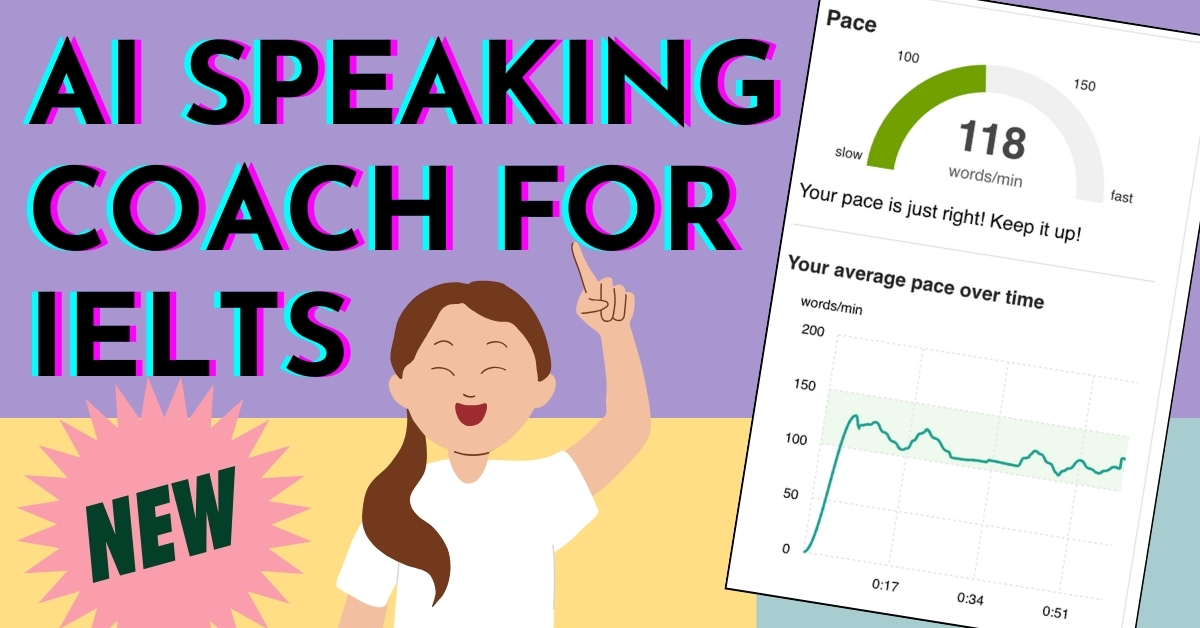It’s called Speaker Coach. It is built into Powerpoint. And, it’s free! (My favorite word)
It’s an AI that listens to you practice your presentation and gives feedback on your performance.
It measures pitch, pace, fluency and vocabulary range. Pretty cool and pretty useful even for native speakers!
We can use this in the classroom to help students with public speaking, giving presentations, or even in ESL / IELTS classes to sharpen general speaking skills.
How To Use Microsoft’s Speaking Coach
To turn it on, make a Powerpoint presentation and then go to ‘Present -> Rehearse with coach’. Then just start talking!

How to Get A High Score Using This AI Speaking Coach
Microsoft Speaker Coach is a powerful tool designed to help learners improve their public speaking and presentation skills through real-time and post-presentation feedback. It’s helpful for everyone including native speakers. But, it is especially useful for students stuck in IELTS Band 5. These students struggle with fluency the most because they are trying to get a high score in vocabulary and grammar – but their fluency can’t handle it.
Here’s a breakdown of the main metrics Speaker Coach uses, along with tips tailored for learners at IELTS band 5.
1. Pace (Speaking Speed)

What it means: Measures how fast or slow you are speaking.
Tip: Aim for a natural pace. Band 5 students often speak too slowly due to hesitation. Practise speaking in short, clear sentences and avoid long pauses. Don’t rush—focus on finishing your sentences calmly.
2. Pitch (Voice Variety)

What it means: Checks if your voice sounds flat or has good variation.
Tip: Use a natural, lively tone. Avoid speaking in a monotone, which can make you sound bored or unsure. Practise reading aloud with feeling—pretend you are telling a story to a friend. Use your emotion on the most important words.
For example, ‘I LOVE pizza’.
The words ‘love’ will be higher pitch and louder.
Can you guess that I really love pizza?
That’s why we use pitch – to communicate to the listener our true feelings!
3. Filler Words

What it means: Tracks how often you say “um,” “uh,” “like,” etc.
Tip: It’s okay to use a few, but try not to rely on them. Silence is better than “ummm.” Use a short pause to think instead. Practise saying one full idea at a time.
Check out this blog for more world-class fluency tips.
4. Repetitive Language

What it means: Notices when you repeat the same words or phrases too often.
Tip: Band 5 students often reuse words like “good” or “nice.” Try using synonyms or simple descriptive language. Prepare a small list of words related to the topic before speaking.
IELTS topics are usually quite limited – you normally have to talk about yourself, and other people!
5. Pronunciation
What it means: Gives feedback on whether your speech is clear and easy to understand.
Tip: Speak slowly and clearly, especially difficult words. Listen to model answers and repeat them. Record yourself and compare with native speakers. If your pronunciation isn’t controlled, then speak slower until you get stronger!
6. Originality (in PowerPoint mode)
What it means: Tells you if you’re reading from slides or speaking naturally.
Tip: Practise using notes instead of full sentences. In IELTS Speaking, you must speak naturally, not read. Use cue cards and talk freely about your ideas.
7. Inclusiveness (more advanced)
What it means: Encourages respectful and inclusive language.
Tip: Be polite and respectful. For example, say “people with disabilities” instead of outdated terms. This may be more relevant for higher bands or academic presentations.
Final Advice for Band 5 Students
- Use Speaker Coach regularly to track your progress.
- Focus on one metric at a time (e.g., just pace or fillers).
- Practise short 1–2 minute talks and review the feedback.
- Set small goals, like “Today, I will reduce my ‘ums’” or “I will speak with more energy.”



